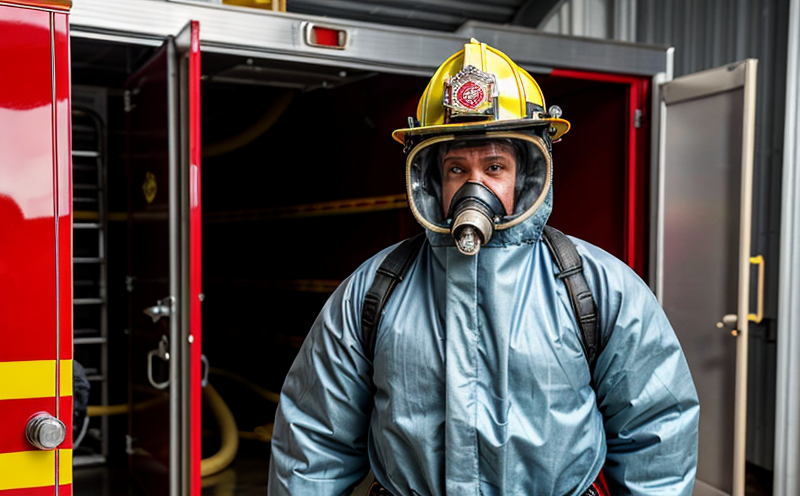Abrasion and Tear Resistance Testing of Fabrics
The abrasion and tear resistance testing of fabrics is a critical component in ensuring the safety and durability of firefighter protective clothing. This test evaluates how well the fabric resists wear and damage, particularly under conditions that simulate real-world use scenarios such as friction against rough surfaces or accidental tearing during emergency operations.
Firefighter protective clothing must withstand harsh environmental conditions, including prolonged exposure to high temperatures and abrasive materials. The abrasion resistance of a fabric is its ability to resist wear when subjected to continuous rubbing or friction over time. This property is crucial in maintaining the integrity of the garment, preventing it from wearing down prematurely.
The tear resistance test assesses the strength of a fabric's structure by measuring how much force is required to initiate and propagate a tear through the material. This is particularly important for ensuring that the clothing remains intact during strenuous activities like climbing or dragging heavy equipment through debris.
Standard testing methods such as ISO 16628-3:2014 for abrasion resistance and ISO 13934:2015 for tear resistance are widely recognized and used in the industry. These standards provide a consistent framework for performing these tests, ensuring that results are comparable across different laboratories.
During testing, fabric samples are subjected to controlled conditions that mimic real-world scenarios. For abrasion testing, this typically involves rotating the sample against an abrasive wheel or surface under specified loads and speeds. The sample is then visually inspected for damage such as wear or fraying at predetermined intervals. The degree of damage is quantified using established criteria.
For tear resistance tests, samples are clamped into a fixture and subjected to increasing tensile forces until the fabric begins to tear. The force required to initiate this tearing is recorded. This value provides insight into the material's strength and durability under stress.
The results of these tests play a vital role in quality assurance processes. They help manufacturers identify areas for improvement, ensuring that their products meet or exceed regulatory requirements. For procurement officers, these test results offer confidence that they are selecting high-quality materials and equipment. R&D engineers can use the data to innovate and develop new fabrics with enhanced performance characteristics.
By incorporating abrasion and tear resistance testing into their quality control protocols, organizations involved in fire safety can enhance both the performance and longevity of their protective clothing. This not only improves operational efficiency but also contributes to the overall safety and well-being of firefighters.
- Ensures compliance with international standards such as ISO 16628-3:2014 and ISO 13934:2015.
- Provides quantitative data that can be used for continuous improvement in fabric manufacturing processes.
- Helps identify potential weaknesses in the design or selection of materials, allowing for targeted enhancements.
- Promotes confidence among end-users regarding the reliability and durability of protective clothing.
Why Choose This Test
Selecting the right test for abrasion and tear resistance can significantly impact the performance and reliability of your fabric. Here are several reasons why this testing is essential:
- Enhanced Safety: Ensures that firefighters have the best protection possible against wear and damage.
- Regulatory Compliance: Helps manufacturers meet stringent regulatory standards for protective clothing.
- Durability: Identifies fabric strengths and weaknesses, leading to longer-lasting products.
- Innovation: Provides valuable data that can be used in the development of new fabrics with improved performance characteristics.
The abrasion and tear resistance testing is a cornerstone of quality assurance for fire safety equipment. It ensures that the protective clothing meets high standards, providing peace of mind to both manufacturers and end-users.
Quality and Reliability Assurance
Incorporating abrasion and tear resistance testing into your quality control protocols is essential for maintaining high standards of performance and reliability in fire safety equipment. This testing not only ensures that the fabric can withstand the rigors of real-world use but also provides a benchmark against which future products can be improved.
The results of these tests are used to identify areas where current practices or materials could be enhanced, leading to better-performing garments. For manufacturers, this means being able to meet and exceed regulatory requirements with confidence. For procurement officers, it translates into selecting high-quality materials that will perform consistently over time.
Continuous improvement in fabric manufacturing processes is driven by the insights gained from these tests. By understanding where fabrics fail or excel under specific conditions, developers can refine their products to better suit the needs of firefighters and other professionals who rely on protective clothing for safety.
Competitive Advantage and Market Impact
In a competitive market, having robust quality control measures in place is not just beneficial—it's essential. Abrasion and tear resistance testing provides you with a clear advantage by ensuring that your products meet or exceed industry standards. This can translate into enhanced reputation, increased customer satisfaction, and ultimately greater market share.
By demonstrating a commitment to safety and reliability through rigorous testing protocols, companies can build trust among their customers. In an era where transparency is key, being able to showcase the results of these tests adds credibility to your brand. This can be particularly valuable when marketing new products or entering new markets.
The ability to consistently produce high-quality protective clothing also opens up opportunities for partnerships and collaborations with other organizations in the fire safety sector. A reputation for excellence attracts not only customers but also potential collaborators, fostering a positive cycle of innovation and growth.





